#1452: Group FaceTime returns, #DeathToAutoPlay, Highland 2 reveals gender balance, OmniFocus 3 review
If you use Group FaceTime, you can re-enable it by updating iOS 12 and Mojave now that Apple has fixed the nasty bug that allowed callers to eavesdrop before you answered. Do you hate it when videos play automatically, like the previews in the Netflix Apple TV app? Join Adam Engst’s #DeathToAutoPlay campaign to put pressure on Netflix (and other companies) to make auto-play an option. Have you noticed that women generally play lesser roles in Hollywood movies? Michael Cohen looks at Highland 2’s Gender Analysis tool for screenwriters, which reveals just how unbalanced a script is. Finally, for those who are continually looking for the ultimate productivity tool, Jeff Porten reviews OmniFocus 3, a powerful task manager for getting things done. Notable Mac app releases this week include EagleFiler 1.8.6, Transmit 5.2.3, Boom 3D 1.2.4, Alfred 3.8, and Mellel 4.1.5.
Apple Re-Enables Group FaceTime with iOS 12.1.4 and macOS 10.14.3 Supplemental Update
After 14-year-old Grant Thompson discovered that a caller could listen in on another FaceTime user while the device was ringing, Apple quickly disabled Group FaceTime until it could resolve the problem (see “Apple Disables Group FaceTime to Block Glaring Privacy Hole,” 29 January 2019). Apple later addressed the bug on the server side (see “Apple Fixes Group FaceTime Bug; Promises to Improve Bug Reporting Process,” 1 February 2019), but said additional software updates would be required to re-enable Group FaceTime.
Those updates are now here in the form of iOS 12.1.4 and macOS 10.14.3 Supplemental Update. You can obtain iOS 12.1.4, which weighs in at 89.6 MB on an iPhone X and 65 MB on a 10.5-inch iPad Pro, in Settings > General > Software Update or through iTunes. The macOS 10.14.3 Supplemental Update weighs in at 987.7 MB, and you can install it from System Preferences > Software Update.
Don’t expect any new features from these updates, as they’re aimed at resolving the Group FaceTime bug. However, Apple took the opportunity to fold in a few other security fixes, providing a total of four in iOS 12.1.4 and three in macOS 10.14.3 Supplemental Update. (Interestingly, in the security notes, Apple credits both Grant Thompson and Daven Morris of Arlington, TX for identifying the FaceTime bug—Morris hasn’t previously been mentioned in any press reports.)
Unless you’ve been missing Group FaceTime, it would be wise to wait a couple of days to make sure these updates don’t introduce any new issues. Remember since Apple fixed the bug on its servers, this update isn’t necessary to protect yourself from the exploit, merely to re-enable Group FaceTime.
#DeathToAutoPlay—No More Audio and Video That Plays Automatically!
Most technology annoyances fall into the category of “death by a thousand cuts.” Tiny text on dark backgrounds, controls that appear only when you mouse over an otherwise unremarkable spot, links that don’t stand out from surrounding text, and so on. We won’t even get into all the crud that happens silently in the background, with companies tracking your every move and monetizing every bit of personal information you disclose, knowingly or unknowingly. It’s no longer the Internet I signed up for.
But there’s one trend that’s so blatant, so patently offensive, so callously disrespectful of our time and attention, that we can no longer sit by and suffer. I am of course speaking of the dreaded auto-play videos. There is little more surprising—or even alarming—than having audio start blasting from your speakers while something starts moving before your eyes. It triggers all sorts of fight-or-flight reactions buried deep in our brainstems, wakes the kids, and scares the pets.
Over at the New York Times, Brian X. Chen penned a thoroughly reasonable column explaining why advertisers use auto-play videos and some of the technical solutions for reducing their impact. Google Chrome tries to prevent them from playing based on your behavior, and Safari on the Mac, which Chen doesn’t mention, can also block them, either for a particular site or for all sites. And Firefox 66, due in March 2019, will mute all auto-playing videos.
But I’m not feeling reasonable. I’m as mad as hell, and I’m not going to take this anymore! (To quote the 1976 movie Network.)
The auto-play offense that has pushed me over the edge is Netflix’s Apple TV app, which auto-plays previews for movies and TV shows as you browse through Netflix’s library. Within 3 seconds of when you navigate to a show’s icon, it starts playing a preview for the show, complete with audio. It’s difficult even to read the show’s description in that amount of time, much less reflect on whether you might want to watch the show. As soon as the audio starts, it interrupts whatever thoughts might be going through your head (Josh Centers made this example video; it shows what he hears as his 5-year-old browses).
Worse, sometimes the audio is wildly inappropriate for children who might be listening. While I was writing this article, Sarah Perez of TechCrunch tweeted about the obscenity-laden preview of the Netflix show Russian Doll, and the preview of another Netflix show, Sex Education, leads with “I’ve noticed you’re pretending to masturbate and I was wondering if you wanted to talk about it.” Looking forward to that conversation with your 9-year-old?
(This is different from Netflix’s Post-Play “feature” that automatically starts the next episode in a TV series if you don’t navigate away from the credits screen as one episode ends. Some devices will even automatically play related titles after you finish the last episode in a series or a movie. Personally, I consider this behavior nearly as offensive as the auto-play previews, but at least Netflix lets you turn Post-Play off.)
Netflix is far from alone here. The most egregious offender in the Apple world for years was the Macworld Web site, which still auto-plays videos on many of its pages but now appears to default to muting the audio. (I gave up on Macworld long ago in protest of this behavior, in large part because the management also ignored the complaints of the writers over whose articles the videos played.) On a quick spin through the Web, CNN now seems to be among the worst when it comes to forcing you to listen to some video’s audio while you attempt to read a news article.
Auto-play videos are horrible for usability. As Amy Schade of the Nielsen Norman Group says,
When users arrive at a webpage, they don’t appreciate being surprised by video or audio content that begins playing without their consent. Video, and the accompanying audio, can confuse or distract users, and can interfere with their consumption of content on the page.
Those users who do not want to watch the video must devote cognitive resources and extra effort to figure out how to turn the audio off or pause the video, rather than focusing on their goals and information needs. Any movement on the page can be a distraction.
I’d go further and suggest that auto-play videos are an assault on our autonomy as human beings. They’re an insidious effort to eliminate our free will and compel us to behave in a particular way: “Don’t read that. Watch this instead.” (Best read in an Obi-Wan Kenobi “These aren’t the droids you’re looking for” voice.)
Sure, it’s just a small encroachment on free will now, but auto-play videos exist because they are supposedly more effective for advertising and stickiness. And at least on Netflix, we’re paying for the privilege of being manipulated! Just because something is effective doesn’t mean it’s acceptable. If we sit idly by now, who knows what companies will try next to get us to watch, click, like, or buy.
So let’s fight back. If these companies shoving these videos in our faces aren’t willing to at least provide options to turn them off, let’s exercise our right to be annoying right back with a little constructive—and hopefully costly—criticism. Perhaps auto-play videos are effective in some ways, but they’re offensive in many others. We don’t have to sit and take it like couch potatoes, especially when we’re paying customers!
Since Netflix is what’s making me crazy right now, I called the company’s customer support line at 866-579-7172 and asked how to turn off the auto-play previews in the Apple TV app, knowing full well that it wasn’t possible. I had to clarify a few times that I wasn’t talking about the Post-Play feature, and I made it clear that I found the auto-play previews so annoying that they were causing me to avoid Netflix.
Eventually, after checking with higher-level support a few times, my rep came back and admitted that what I wanted couldn’t be done. He said he would pass my feedback along to his supervisor though, and when I noted that I knew others who were equally as perturbed, he encouraged me to spread the word, saying, “The feature will be gone as soon as enough people tell us that they don’t like it, so please have anyone else you know who’s experiencing this get in touch.” Now that’s what I like to hear.
That call took 13 minutes (in my AirPods, while I was writing and editing this article, so it was only a couple of minutes of my time). A few sources on the Internet suggest that it costs about $1 per minute for an average call center to service a call. So my call cost Netflix $13, meaning that the company lost money on me for the month. How about we scale that up? While we’re at it, let’s throw a spotlight on Netflix’s behavior on Twitter too.
To make our rebellion more high-tech, I’ve created a simple shortcut in iOS 12’s Shortcuts app to simplify contacting Netflix. It assumes that you have two apps installed on your iPhone: Shortcuts and Twitter, but if you don’t use Twitter at all, you can delete those steps in the shortcut. After you’ve downloaded those apps, on your iPhone, add this shortcut to your Shortcuts app and then switch to the Library view to access it. You may need to allow the Call action access to your contacts, but it works purely from entered text.
When you invoke the shortcut, it does two things:
- First, it posts a tweet to @Netflixhelps asking if Netflix has come up with a way to turn off auto-play previews yet. The shortcut has some suggested text for your tweet, but I encourage you to customize as you like—just leave the #DeathToAutoPlay hashtag so the tweets pile up in Twitter.
- Second, it calls Netflix support, where I encourage you to ask if such an option exists, and when you’re told that it doesn’t, ask that the support rep pass the feedback along to management. Stay civil—it’s not the support rep’s fault—and remember that the goal is to cost Netflix money and ratchet up those feedback requests. Call just once in a month, and Netflix will lose money on you for the month. Call more frequently and the company’s support costs will skyrocket.
To invoke the shortcut, I recommend recording a phrase you can use with Siri. Tap the toggle-switch icon at the top right of the shortcut, tap Add To Siri (it changes to Siri Phrase once you’ve recorded), and then record your phrase. I recommend “Death to auto-play!” because it’s fun to say.
Then, whenever you’re browsing through Netflix and being harassed by the auto-play previews, pull out your iPhone, invoke Siri, and say “Death to auto-play!” The shortcut will queue up a tweet that you can edit or just post by tapping the Tweet link (you may have to tap the hashtag to dismiss it first). Then it will dial Netflix support so you can have a costly conversation with a nice support rep.
Now I don’t want to pick on Netflix. Wait, yes, I do! But we shouldn’t forget that CNN and other companies deserve similar treatment (wikiHow has a How to Contact CNN article for Twitter handles and phone numbers). Feel free to repurpose my little shortcut for whatever company is trying to take over your brain with auto-play videos. Let’s get that #DeathToAutoPlay hashtag trending!
Highland 2 Helps Screenwriters Balance Genders
Did you know that, among the 100 top-grossing films in the United States in 2017, only 24% featured female protagonists, just 37% had female major characters, and only 32 of the 100 films featured 10 or more female characters with speaking parts (compared to the 79 that contained speaking parts for at least 10 male characters). When it comes to cinematic characters, the default setting is “male.”
Nor are many of the roles available for female actors particularly deep or challenging, a state of affairs so commonly recognized that the phrase “fails the Bechdel Test” has become a shorthand cliché for a movie that offers little range for its female actors. The Bechdel Test doesn’t set a very high bar: to pass it, a film need have only one scene in which two named female characters talk to each other about anything other than a man. Nonetheless, in 2018, among the releases that failed the Bechdel Test were the Oscar-nominated Green Book and the summer blockbuster Mission Impossible: Fallout.
Of course, characters originate in screenplays, and, as it happens, the Highland 2 writing app provides some simple but effective assistance for “woke” screenwriters who want to pay more explicit attention to the gender balance in their screenplays. We wrote about Highland a while back (see “Writing Screenplays with Highland,” 18 May 2015), and while the latest version has evolved into a full-blown Markdown editor with lots of writer-friendly features, its forte is still screenwriting. Among the tools in its current incarnation is one labeled Gender Analysis.
The Gender Analysis tool is simple in concept—it lists the speaking parts that Highland finds in a screenplay (not a feat of artificial intelligence analysis: the rigid screenplay format makes compiling such a list trivially easy), and then requires the user to tick a checkbox manually for each character to indicate the character’s gender. Nor does the analysis take into account gender fluidity: you can choose only M for male, F for female, and U for unspecified.
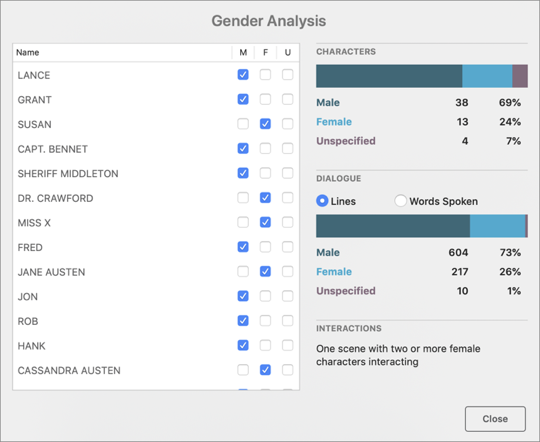
With those boxes ticked, a screenwriter can see how many characters of each gender appear in the screenplay, how many lines or words the characters of each gender speak, and how many scenes the script contains that feature at least two female characters interacting. That last statistic is as close to a Bechdel Test analysis as the software can go: while it can find scenes where two or more female characters speak, the Gender Analysis tool can’t tell if the characters are talking about a man.
Rudimentary as it is, Highland 2’s Gender Analysis tool does provide useful feedback. To try it out, I took a PDF I received a few months ago from a friend that contained a draft screenplay he’d written, and I “melted” it into Highland 2. (“Melting” is what Highland calls extracting the text of a properly formatted screenplay PDF into Highland’s own format; it’s a simple drag-and-drop operation.) I then opened the Gender Analysis tool, ticked the checkboxes, and learned that the draft was a typical Hollywood screenplay: more than two-thirds of the characters were male, and they delivered most of the dialog. The screenplay did contain one, albeit only one, scene that depicted two female characters speaking. When I read that scene, I found that it did pass the Bechdel Test because its dialog did not mention any men.
I had expected such results: the script was an action-comedy about twin brothers, one a cop, the other a convict, so it promised to be a phallocentric tale from the get-go. In fact, I was surprised that it included even one scene that passed the Bechdel Test. When I called my friend to tell him of Highland’s findings, he laughed and told me that not long after I received the draft, he had done a similar gender census on the screenplay and, based on that, had changed a number of minor characters from men to women.
What can we learn from this? Most importantly, that analyzing a screenplay for gender balance doesn’t require sophisticated artificial intelligence. Highland 2’s basic Gender Analysis tool makes it easy, but all that’s really necessary is a simple bookkeeping chart and a calculator. What matters most is being aware that cinematic gender balance is an issue in the first place, being willing to investigate that balance, and then being willing to take some action based on the investigation. And the reward for that work? Maybe more and better parts for female actors. That’s a coming attraction I would pay to see.
OmniFocus 3: What’s New and What’s Blue in Task Management
Project and task management is a complex topic that has spawned thousands of apps and just as many strong opinions about each of them. I’ve been trying new tools since I started with a Casio Databank watch in high school and a Sharp Wizard in college. If you don’t remember these tools with nostalgia, you’ll think them horribly antiquated—but for many years, Mac task management software was not much better. It wasn’t until ten years ago that Mac apps in this field began to be consistently useful out of the box.
This decade of worthwhile software roughly coincides with the initial release of OmniFocus, which helped to create a market in which many apps now compete. OmniFocus has been reviewed here at TidBITS increasingly warmly (see “OmniFocus Willing, But Not Quite Ready, To Help Get Things Done,” 30 April 2008, and “OmniFocus 2 for Mac Brings a Fresh Look to GTD,” 22 May 2014).
OmniFocus 3 is now a multiplatform app, although it works perfectly fine by itself on Mac or iOS. OmniFocus is now roughly feature-compatible on Mac and iOS with the differences mostly relating to the different times and ways the hardware is used. But the experience of using OmniFocus on an iPad and iPhone is quite different, so I think of OmniFocus as a suite of tools crossing the Mac, iPad, iPhone, Apple Watch, and—soon with the release of software now in public beta—the Web.
The release of the Web version will bring with it an alternative pricing scheme. OmniFocus apps will still be available for one-time purchase, but there will also be a subscription model that provides the latest Pro version of every app—and which will be required to use the Web app, with lower pricing if you’ve also purchased the apps. The monthly subscription of $5 or $10 may reduce the sticker shock of buying the apps, as the Pro versions (which I recommend) total $140 on Mac and iOS, dissuading new users.
The problem with OmniFocus, and task management apps in general, is that each requires you to adopt a particular way of looking at your goals, projects, tasks, and time management. Complex apps like OmniFocus give you more freedom to adapt the software to reflect your work style, while simple apps force you into a particular method that may or may not match your natural style. To demonstrate how OmniFocus presents both complexity and flexibility, I’ll start with an overview of how it works, and follow it with a discussion of what’s new in OmniFocus 3 and where it has some rough edges.
Disclosure: After the publication of my book Take Control of Your Productivity, the Omni Group contracted me to write a post for their blog Inside OmniFocus—which I’ll link to later as it’s relevant to this review. I may do similar work in the future but have no ongoing relationship with the company.
An Overview of OmniFocus
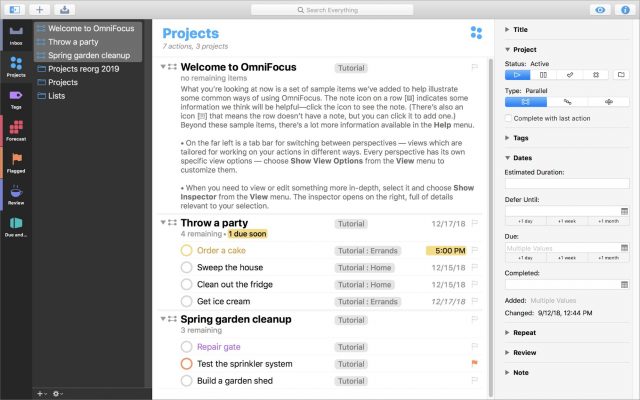
This screenshot provides a good overview of both OmniFocus and what I meant earlier by “flexibility with complexity.” There are four sections, from left to right:
- View Column: The icons in the leftmost black column switch the view of your data. From the top down:
- An inbox that catches incoming tasks you haven’t organized yet.
- A projects view that displays nested outlines of your projects and tasks.
- A tags view that collates tasks by categories you define, taken from multiple projects and presented as a simple list. For example, you may tag tasks with places like “Home” or “Errands,” or with concepts like “Work” or “Volunteer.”
- A forecast view showing past, present, and future tasks with due dates, which are displayed alongside events from your calendar so you know how much time is left over to accomplish them.
- A flagged view allowing you to note some items as important or special, and display them separately.
- A review mode for a regular process of checking your projects and tasks, to make sure they are up-to-date with what you’ve done and properly organized to reflect any changes that have occurred.
- Additional custom views that you can design, called Perspectives. In this example, you’re seeing the icon for my “Due and Available” Perspective, showing me what’s on deadline but omitting things I can’t do now—so I’m not bothered by my laundry hamper when I’m not home.
- Navigation Column: The dark grey column shows a navigational structure. In this example, the projects view is selected, and it displays folders and projects only, for quick navigation of your outline. In the tags view, it shows your defined categories. In the forecast view, it shows a calendar with counts of tasks for every day in the next month.
- Projects and Tasks Column: The center white column displays your projects and tasks in a list—an outline in the Project view and simpler lists in Inbox, Flag, and Tag views. You can modify this column to be simpler and show less information for each task.
- Inspector Column: The rightmost column shows all the data for the selected task. As you can see, every project and task can have quite a lot of data associated with it—start dates, due dates, repeat schedules, notes, and estimated times among them. You don’t have to use all this metadata, and you can collapse sections and rearrange them so the Inspector shows you what you use most often.
When you’re working with the Projects and Tasks column, you’re frequently going to be using an outline in the projects view. You can nest tasks to break a project down into subprojects, and those tasks can have subtasks. This is useful for complex projects but can raise the question of when to decide a task with subtasks is large enough to be its own project. It doesn’t matter whether you think of a nested task as a subproject or just a grouping of even smaller tasks, but OmniFocus treats projects at the top level differently. When you’re working in a simpler view that lists tasks without a project hierarchy, it’s frequently useful to quickly switch back to see the task in the larger project, and OmniFocus provides that capability in a contextual menu.
Tasks and projects can be assigned tags, allowing for additional categorization. Tags replace what used to be called “contexts” in earlier versions of OmniFocus. You can best think of a context as a filter because a key use of tags is to see only what’s relevant to the situation at hand. It isn’t helpful to see a reminder to buy eggs when you’re in the office—you want that while at the grocery store—but you’ll likely want to see the reminder you need to go grocery shopping everywhere except at the supermarket.
A project or task with subtasks can be sequential with all its components occurring in order, or it can be parallel, where you can do them in any order. Putting on your socks and shirt is a parallel task, but putting on your socks and shoes is sequential. Depending on how you set up your task views, you can hide “unavailable” tasks—in the Get Dressed project, you’ll see both “put on shirt” and “put on socks,” but you won’t see “put on shoes” until socks are marked as done. (This example may sound silly but the sequential/parallel dichotomy is useful for the same reason contexts are. You often don’t want to be bothered about things you can’t do right now.) Putting on your clothes is an example of how complex even simple tasks can be, because Get Dressed is a parallel project with nested sequential components—you also can’t put on your coat first or your underwear last. (Unless you’re a superhero.)
Likewise, repeating tasks can also be complex. You have to pay your monthly cable bill on the same day every month, but a monthly meeting could require a task due by the third Friday. If you want a haircut every month and you delay two weeks, you don’t want to see that task two weeks later. Meanwhile, when a repeating task has subtasks—your grocery list includes things you prefer to buy at store #2, where you don’t want to buy what you already picked up from store #1—sometimes the project or container task repeats, and sometimes the individual subtasks repeat. OmniFocus has a system of assigning due dates and defer or start dates, which hides a task until sometime in the future. Repeating tasks can be based on either, with future tasks scheduled either by date or after enough time has elapsed since the last time you completed it.
Finally, task management is something you always want available. You might get organized on your Mac, brainstorm tasks on your iPad over breakfast, and use your iPhone all day long to check things off. OmniFocus has a free syncing service that handles all of this seamlessly, or you can use a private server if you don’t want your data in the cloud. If you have to use other platforms, the beta Web service is intended for non-Apple desktops and laptops, but not yet designed for touchscreens.
For all of the above basic concepts, OmniFocus is either the best in class among Mac and iOS task-management apps, or at least the standard by which other apps are judged. Many of these ideas weren’t implemented well until OmniFocus came up with a decent interface for them—at which point other apps differentiated themselves by responding to the things people disliked about OmniFocus. Concepts like projects with nested parallel and sequential tasks require a more complex interface than apps that don’t include them. If you want fewer features because you’re tripping over complexity, that’s a good reason to use another app. But I generally recommend using software that’s more complex than what you need right now, so you can expand into it in the future. A missing feature is a low ceiling you can bump your head on, and switching task management apps is a painful, time-consuming procedure.
(The most commonly mentioned app for people who find OmniFocus too complex is Things, which has a nice feature set in a cross-platform package. Choosing and switching to a new productivity app is hard to do right, and I recommend against the shotgun approach of downloading apps until you find one that’s superficially useful. This is the subject of several chapters of my book, Take Control of Your Productivity, and its accompanying blog has an article suggesting additional apps once you’ve come up with an approach to evaluating them. OmniFocus, Things, and Daylite don’t appear in the blog post because they’re covered in the book.)
What’s New in OmniFocus 3
While designing OmniFocus 3, the Omni Group focused on addressing problems that users had with confusing complexity and difficulties using contexts.
Tags Replace Contexts
In earlier versions of OmniFocus, a task could only have a single context, which required jumping through hoops to filter them properly. I divide my work tasks up into several categories (to remind me to make money before I switch to more interesting work that doesn’t), but I also want to filter out tasks requiring my Mac when I only have my iPad. In OmniFocus 2, this required nesting contexts, such as Revenue Work:Mac and Revenue Work:iPad. But I also needed Revenue Work:Apple to indicate tasks I could do on either device, but not on my Android phone. It would have been nice to also be able to divide tasks based on other criteria: things that require a fast Internet connection, or things I can do when I’m tired.
Tags solve this problem nicely, because a task or project can have any number of them. Instead of a ridiculously complex and repetitive context structure, I can create a task and tag it [NonRevenue] [Mac] [iPad] [Low Ebb]. I’ll filter it out until I’m done with more important categories of work, and also by available gadgetry or current neural functionality.
This screenshot shows a tag view of tasks I brainstormed for this article. (Unfortunately, I actually need to do them.) This view is good for prioritizing but not filtering. You’ll never need to see your “Low Ebb” and “On Fire” (mentally) tasks side-by-side, as you would filter for those only when in one state or the other. Custom perspectives are how you filter these tasks with more precision, as you can create views that show “only those tasks with both of these tags,” or “every task except the ones with these tags.”
Tag nesting is still available and sometimes useful: when I tag a task with a person in order to have a ready-made agenda for when we meet, I nest that as People:Josh Centers, which allows me to pull up a People list to see all of the agendas I have to prepare for. This is also useful for keeping a long list of tags organized—I nested my tags in this screenshot in order to avoid showing you all the ones I actually use.
Better Perspective Layouts
Different kinds of work have different requirements, and now you can change layouts and the data you’re shown to match those requirements. Most of the time when I’m working on my tasks, I want to see a Tag or Forecast view with projects, flags, and due dates listed alongside. But when I’m planning future work, I’m in a Project view and also want to see start dates and notes.
It was already possible to toggle display options in OmniFocus’s preferences, but custom perspectives allow you to create sets of options assigned to each view. Perspectives also have task rules similar to smart playlists in iTunes, and let you control what you see in your custom layout. On the Mac, customization is more powerful than before, and in iOS, it’s the first time you can do it at all. Custom perspectives will sync between your devices (but not to the Web app), although in some cases you might want to create platform-specific perspectives regardless in order to make the formatting better suited for the size of the screen you’re using.
Customizable Inspectors
OmniFocus now has project and task inspectors. This change lets you hide interface elements in the task list that you might need only occasionally, and display them only as needed. On the Mac, you can turn sections of the inspector on and off by clicking disclosure triangles. On an iPad, you choose which elements to hide by default, and how to arrange more elements when you tap Show More.
Adaptive controls and custom ordering of the inspector categories also help make the inspector easier to manage: a date picker appears only when you tap a date, a second sidebar slides in when you set a task’s repeat schedule, and you can rearrange your most commonly-used options to the top of the inspector.
Where OmniFocus 3 Is Still a Bit Blurry
Like most apps that have been around for a decade, OmniFocus is generally polished. The woes and suggestions of thousands of users have all contributed to this third version, and it shows. But several problems remain, some of which are related to new cross-platform capabilities.
The biggest of these is that I’ve been using OmniFocus 3 on my Mac and iPad for months, and I still haven’t entirely figured out the iOS interface. I suspect that if you’re iOS-centric, you won’t have this problem. But I do most of my OmniFocus heavy lifting on my Mac, and so when I go to the iPad, there are features I know exist but I can’t figure out the tap targets to invoke them. Most egregiously, the button that shows or hides unavailable tasks—which you’re going to use often—is in different places on the two devices, so I regularly find myself looking into the wrong corner of the screen on both the Mac and iPad.
One solution to the user interface problem is to read the excellent help, which is high quality and written like a manual. (OmniFocus 2 used to provide in-app help as downloadable EPUB ebooks, and I hope Omni Group brings those back. Few people sit and read a manual cover to cover, but it’s a good idea with OmniFocus.)
I would love to visit OmniFocus’s developers and see how they arrange their OmniFocus windows, especially when working from a coffee shop. The next issue would be less troubling on a 27-inch display, but my work is entirely mobile and my workflows are built around MacBook and iPad-sized screens. The OmniFocus window takes up most of the display, so I make it a full screen in Mission Control to avoid having stacked windows. That means I need one Space for OmniFocus to tell me what to do and another Space where I do it. When that work requires me to make ongoing changes in OmniFocus for documentation, I need my iPad as a second screen to avoid switching every two minutes—either showing the iPad version of OmniFocus or working as an external monitor with Duet Display showing my Mac’s OmniFocus window. There are times when I don’t have room for the iPad—planes, buses, Starbucks during rush hour. My instincts tell me there’s probably a better way of working with a small OmniFocus window—such as creating custom perspectives that pop up additional windows with compact information views—but it’s not intuitive or easily discoverable. (Writing this made me realize I could also create a new tag so I can filter out tasks that need two screens.)
That leads me to the last issue. I’ve used OmniFocus since almost the day version 1 was released, and before then, I used its spiritual predecessor. I’ve written a book that features the app prominently. But this review has required long notetaking and research, because whenever I’ve said “you can’t do such-and-such,” I’m still not entirely sure there isn’t a particular 12-step procedure that fits it into OmniFocus methods. (In such cases, I frequently check the OmniFocus forum to either find someone’s clever solution or at least commiserate with other people facing the same problem.) After 10 years of non-stop usage, I feel like I should know its edges and limits better.
This problem was significant enough that I cheekily wrote a story for the OmniFocus blog on when not to use OmniFocus. I did this partially because it’s common to hear people trying to use their task management app to organize and store everything without regard to whether that’s a good idea. Sometimes it’s just easier to pop up a TextEdit window to make a quick list than it is to create and use an OmniFocus perspective. But maybe I’m still using tricks like that because I’m confused about what OmniFocus can and can’t do. Is it too much to expect that I should be able to maximize the productivity tool that I use to manage my productivity? I don’t think I’m there. (In fact, I’m sure I’m not, as I haven’t yet learned OmniFocus 3’s AppleScript commands or iOS Shortcuts.)
In short, OmniFocus has extensive help documentation in the app and on its companion Web site, plus the aforementioned forums. OmniFocus has a steep learning curve, and if you’re just getting started, you should be prepared to scale it. (Note that looking for OmniFocus documentation may land you on a site called Learn OmniFocus. It’s designed to look like the Omni Group Web site, but it’s a different company selling training. The owner of the business has an ongoing interaction with Omni Group and they’ve recommended his work in the past. But I’ve landed here a few times over the years and this is the first time I became aware it wasn’t an Omni Group site, so I think it’s worth mentioning to avoid any confusion.)
OmniFocus’s complexity isn’t entirely the Omni Group’s fault because all productivity methods require a time cost overhead. OmniFocus is no exception. There are tasks that I call “meta-tasks,” which are what you have to do to manage your productivity system. (If you spend 10 minutes every day brainstorming a to-do list, that’s a repeating meta-task.) Some of these are inherent to an organizational method, such as time you spend reviewing current projects and tasks to see if they’re up-to-date. But other meta-tasks can be specific to how the app works. It takes me 10 minutes to set up at Starbucks with my iPad as a second screen; if I could use OmniFocus more effectively on a small screen, that wouldn’t be necessary.
Ultimately, after years of refining and streamlining my task management, I still spend far more time than I’d prefer fiddling with my data instead of checking things off my lists. It’ll probably take a completely different task management paradigm to contrast, in a new app or a future version of OmniFocus, before I can imagine how to solve this problem completely.
The Final Focus
I can’t think of an example of someone who might want to stick with OmniFocus 2; if you like the app, you’ll like the upgrade. If you’ve tried and abandoned OmniFocus in the past, you might find OmniFocus 3 more welcoming, but there’s a catch-22 involved: you can use preferences and custom perspectives to make the interface much simpler, but that’s not how it looks out of the box. You have to learn how to use it in order to make it easier to use.
You can purchase the OmniFocus apps a la carte as one-time purchases for Mac or iOS, or as a subscription across all platforms. The standalone version of OmniFocus 3 Standard for the Mac costs $39.99 and OmniFocus Pro for the Mac is $79.99. The iOS version of OmniFocus Standard is also $39.99, and the Pro version is $59.99. Upgrade pricing is available for earlier versions of OmniFocus, or from the Standard version to the Pro version. I don’t think many people will be satisfied with the Standard version for very long—several features including custom perspectives are Pro-only and they’re too important to skip.
If you want to use the forthcoming OmniFocus for Web, a subscription is required—but if you’ve previously purchased the app, the subscription is half-price. OmniFocus for Web is a stripped-down version of the Mac and iOS apps, meant to be used in parallel, in situations where you can’t use the app; OmniGroup compares it to their first iOS release. If you want to try it out, and you own any OmniFocus 3 app, sync your data to Omni Sync Server and a checkbox on the Web site joins the beta. Subscriptions won’t be available until OmniFocus for Web launches (which their roadmap predicted by the end of 2018, but the beta continues). A subscription will cost $9.99 per month and includes the Pro versions of all apps, or $4.99 per month for just the Web service if you’ve separately purchased the apps you want.

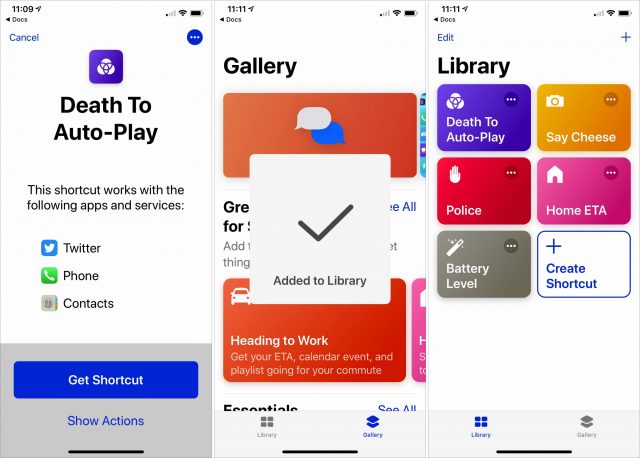
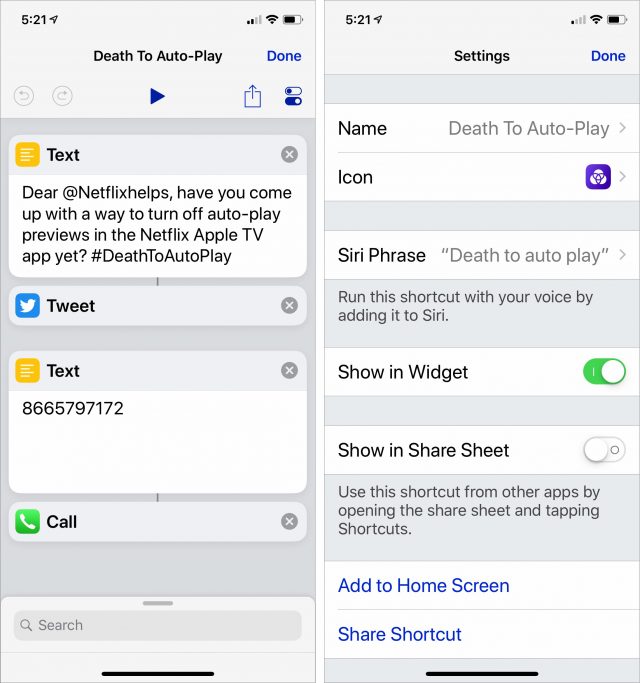
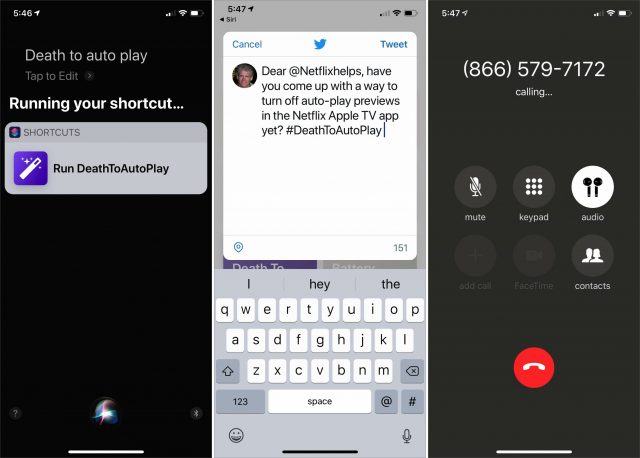
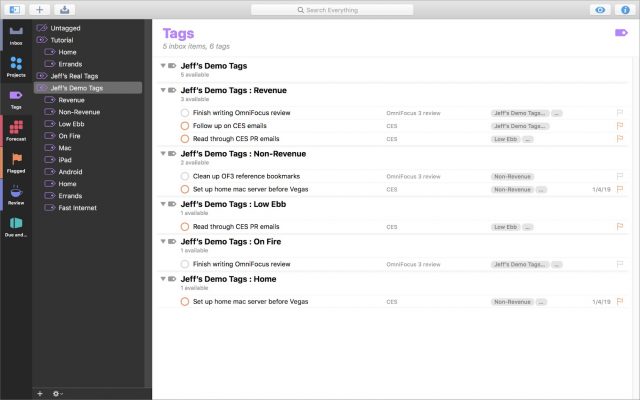
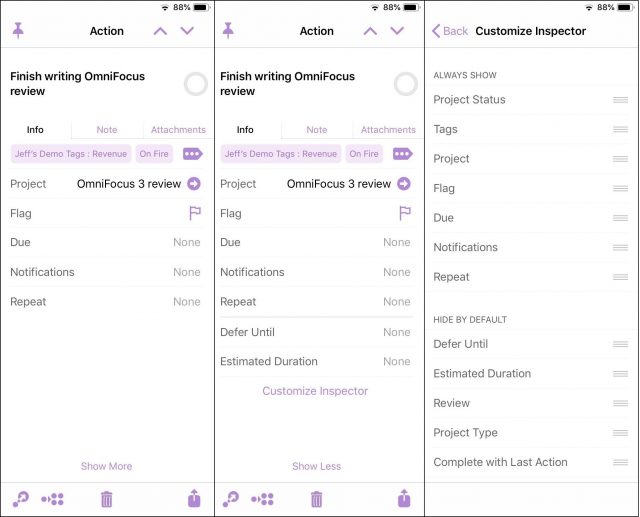
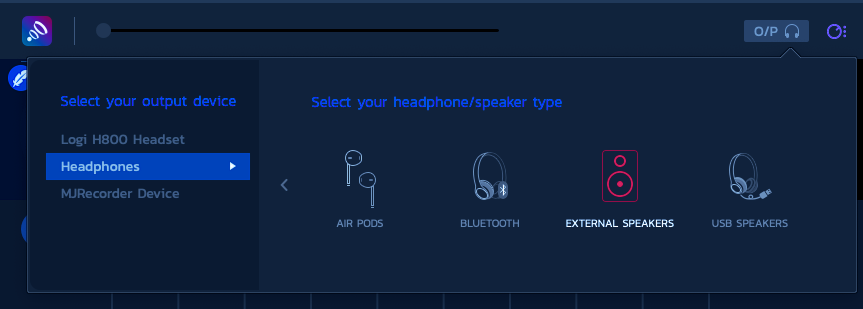
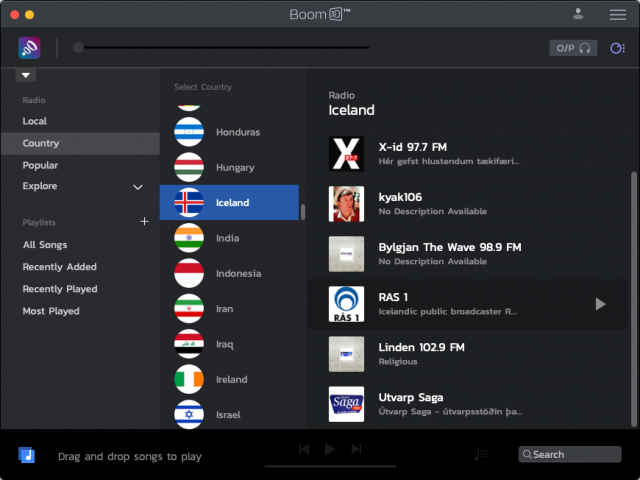
 Josh Centers
7
comments
Josh Centers
7
comments

 Josh Centers
14
comments
Josh Centers
14
comments
 Josh Centers
5
comments
Josh Centers
5
comments
 Josh Centers
No
comments
Josh Centers
No
comments